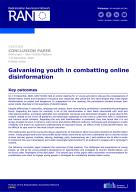Details
- Publication date
- 2 February 2021
- Author
- Directorate-General for Migration and Home Affairs
- RAN Publications Topic
- Vulnerable youth and youth engagement in P/CVE
Description
On 7-8 December 2020, RAN YOUNG held an online meeting for 17 young activists to discuss the consequences of disinformation online and brainstorm innovative new responses that utilise the very technologies that make digital disinformation so potent and dangerous. In preparation for this meeting, the participants combed through their social media channels to find examples of disinformation.
Despite differences in nationality, language and context, there were striking similarities in examples the participants found. Regarding the topics for example, a lot of the disinformation in their feeds intersected with local and international politics, promoted nationalist and xenophobic narratives and demonised refugees. A great deal of this content related to the Covid-19 pandemic and seemingly capitalised on the crisis to undermine faith in institutions and fracture social cohesion.
Regarding the way that disinformation is presented, they also found that it is not always straight forward; it comes in many forms and utilises different mediums, techniques and strategies to create credibility and distort an audience’s understanding of important issues. An effect of this is that disinformation can be difficult to spot even for the most critical consumer.
This meeting also gave the young activists an opportunity to brainstorm about innovative solutions to disinformation online. Young people tend to be more prolific social media users and as such they understand how to use the myriad of tools (stories, games, chatbots, sharing, hashtags, polls, livestreaming, etc.) each platform has to offer in order to transcend one-way transmission and create meaningful opportunities for an audience to engage with a campaign’s content.
The following conclusion paper presents the outcomes of this meeting. The challenges and experiences of young people, as well as the young people’s perspectives on opportunities and strategies to counter disinformation, can be found under ‘Highlights of the discussion’. The second part of this paper offers actionable recommendations for practitioners who want to engage young people in strategies for combatting disinformation online.

